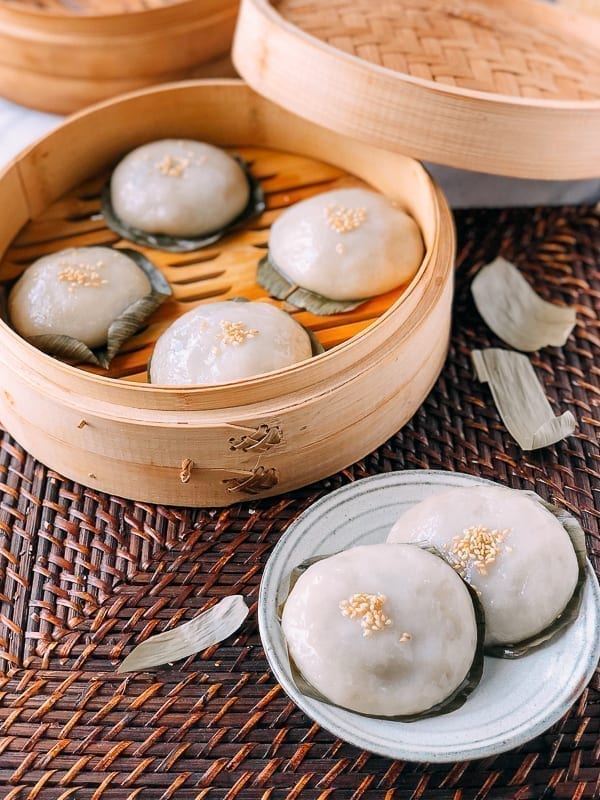Cantonese Cha Guo (Savory Rice Cakes)
4.9
(7)
Your folders
Your folders
Prep Time: 140 minutes
Cook Time: 40 minutes
Total: 180 minutes
Servings: 24
Author : Bill

Ingredients
Export 17 ingredients for grocery delivery
Instructions
Step 1
Prepare the zong leaves by soaking them overnight, rinsing them, and cutting each of the six leaves into four 3- to 4-inch squares. If you can’t find these bamboo leaves, then you can use parchment paper as a substitute.
Step 2
Soak your dried shiitake mushrooms in a bowl of hot water and place a small plate on top to ensure they are fully submerged for 30 minutes. Cut the stems off the mushrooms and discard them. Return the mushrooms to the water if they still seem dry inside, since thicker mushrooms will take longer to rehydrate. Finely chop the mushrooms and set aside, reserving the water you used to soak them.
Step 3
Soak your dried shrimp in hot water for 30 minutes. Pour the shrimp out into a strainer and give them a quick rinse before chopping them.
Step 4
Heat 5 tablespoons (75 ml) vegetable oil in a frying pan or wok on medium low heat. Scoop out about 2 tablespoons of the heated oil and set aside for brushing the cha guo after they come out of the steamer.
Step 5
Add the dried shrimp to the oil and stir-fry until fragrant, about 30 seconds. Next, add the ground pork and stir-fry for another 30 seconds, or until it is opaque. Stir in the chopped shiitake mushrooms and the Shaoxing wine.
Step 6
Next, add the grated daikon radish, chopped scallions, sesame oil, oyster sauce, 1 1/4 teaspoons salt, sugar, and white pepper. Cook on medium low heat until simmering and continue to simmer for another 3 to 4 minutes, or until the daikon radish is just tender.
Step 7
Combine 2 teaspoons cornstarch with 1/4 cup of the reserved mushroom soaking liquid, being careful to avoid any dirt or sediment that may have settled on the bottom of the bowl. Add to the wok, and continue to cook and stir until all standing liquid has evaporated, about 2 minutes. Set aside and let cool completely.
Step 8
In a large mixing bowl, combine the glutinous rice flour, all purpose flour, tapioca starch, and the remaining 1 teaspoon salt. Gradually stir 2 cups of boiling water into the dry mixture and continue mixing with a rubber spatula or wooden spoon until a dough begins to form. Once the mixture is cool enough to touch, knead the dough into a smooth ball. Add extra glutinous rice flour 1 tablespoon at a time if the dough is too sticky to knead. Once smooth, cover the dough in the bowl with an overturned plate, and let it rest for 20 minutes.
Step 9
NOTE: Don’t be thrown off by the amount of dough in the photographs. I made half a batch of dough in these photos, because I decided to freeze the other half of the filling to save for Chinese New Year, when I’ll be making another half batch of fresh dough!
Step 10
Divide the dough into 24 equal pieces about 45 g each, and keep them covered with a clean, damp kitchen towel to keep them from drying out while assembling the cha guo. I recommend using a digital scale to keep the cha guo rice cakes uniform in size.
Step 11
Press each small ball of dough to form a flat disc. Use a rolling pin to roll out the edges of the disc until it is about 3 ½ to 4 inches in diameter. It’s important to make the edges of the disc slightly thinner than the middle, or you will have too much dough on one side after you pinch and close the edges.
Step 12
Next, put 35 g of filling in the middle of the dough disc. Use a spoon to press the filling together into ball so there are no air pockets in the filling. Here, you can again use your kitchen scale to measure how much filling you are using for each cha guo rice cake in order to achieve a uniform size.
Step 13
Next, pinch the dough around the edges of the disc until the opening is closed. The side of the cha guo tea cake you just closed will be the bottom, so no need to worry if the seam is not smooth. Just make sure it is closed and does not leak.
Step 14
Next, brush your reserved “cooked” vegetable oil on one of your cut zong leaves and also on the bottom of the cha guo, and place the cha guo onto the leaf. Gently press until it is flattened slightly.
Step 15
Place the cha guo in a bamboo steamer or metal steamer, ensuring that there is at least an inch of space between each one. You should be able to fit 4 to 5 cha guo rice cakes on one level. Stack your bamboo steamer levels to steam more tea cakes in one batch. Steam your cha guo rice tea cakes in batches for 10 minutes each.
Step 16
Once done, sprinkle a pinch of toasted sesame seeds on top of each rice cake and gently press them in place. Use a basting brush to lightly brush some of the cooked oil you reserved earlier over each cha guo to prevent them from drying out.
Step 17
Remove the cha guo to a plate and serve them warm anytime! You can also let them cool completely and freeze them on a plate, placing a layer of plastic or parchment paper between each layer. Keep them in an airtight freezer bag for up to 1 month.